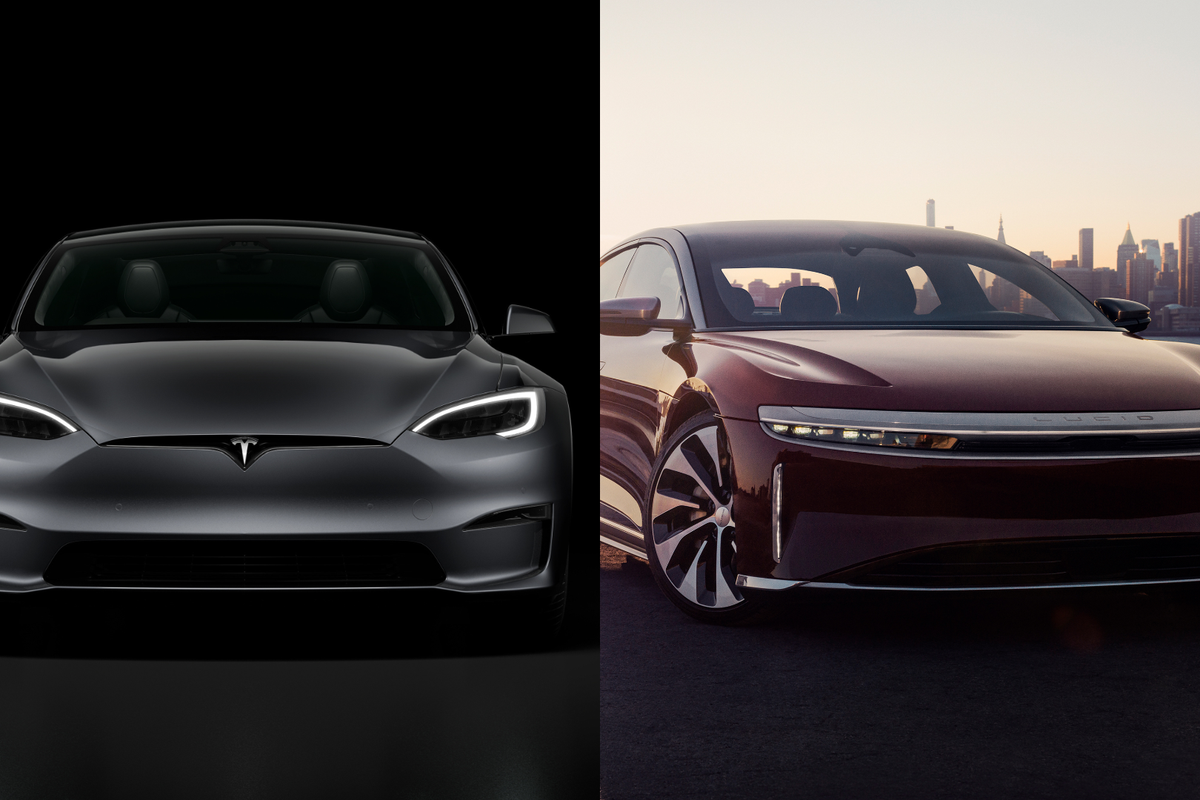[ad_1]
Car experts at Edmunds have compared Tesla Inc’s TSLA Model S Plaid to EV competitor Lucid Group Inc’s LCID Air. The results may be closer than you think.
What Happened: Edmunds experts put the two high-end electric vehicles up against each other and broke them down by four categories: range and charging, performance, interior and tech and pricing and value.
Range & Charging: Lucid has touted its Air sedan as “the longest-range electric vehicle ever rated by the EPA.” Its most expensive Dream edition received an official EPA rating of 520 miles of range on a single charge, which is over 100 miles more than its closest competitor.
The highest range that Tesla offers is 405 miles on a single charge, which trails even the least expensive base model of the Lucid Air.
“In Edmunds’ real-world range test, a Lucid Air Dream Edition Range model traveled 505 miles of its advertised 520 miles. Meanwhile, a Tesla Model S Plaid on the optional 21-inch wheels managed 345 miles in the same test, just short of its 348-mile EPA rating,” Edmunds said.
The Lucid Air is one of few EVs that can use the maximum 350-kilowatt rate available at some fast-charging stations, while the Model S provides a maximum of 250 kilowatts of charging power.
“More range, superior efficiency and faster charging give the Lucid Air the easy win here,” Edmunds said.
Performance: Tesla is known for its eye-popping zero-to-60 times, but Lucid held its own in the performance category.
Edmunds said it clocked Tesla at 2.3 seconds in its zero-to-60 test and it took the vehicle 9.4 seconds to run a quarter-mile.
The Air Dream Edition (Range model) wasn’t far behind. It reached 60 miles per hour in 2.8 seconds. A quarter-mile time was not provided.
“While the Model S delivers better handling out of the box, both sedans offer mind-blowing power, period. There simply cannot be a loser in this category,” Edmunds said before declaring a tie in performance.
See Also: Tesla Rebounds Following Post-Q3 Deliveries Meltdown: Here’s What To Watch
Interior & Tech: Edmunds wasn’t crazy about either company’s interior approach, citing Tesla’s odd steering yoke and removal of traditional column stalks for touch-sensitive buttons, which makes “simple commands more distracting while driving.”
Edmunds noted that many of its staff have reported “painfully slow responses” from the Lucid Air’s touchscreen and entertainment system. The Air also has problems with some of its advanced safety features, but both Tesla and Lucid can address said issues with over-the-air updates, the car experts said.
Edmunds didn’t select a winner (or loser) in this category either.
Pricing & Value: The pricing of the vehicles varies by model, but all of them are quite expensive by just about anyone’s standards. The base Lucid Air, which isn’t yet available, is expected to start at $87,400, but the Dream Edition costs $170,500. On the other hand, Tesla’s Model S starts at $105,000 and the Plaid trim model costs more than $137,000.
Both vehicles tend to run into build quality problems and both companies offer similar base warranties, yet Tesla’s powertrain warranty is “slightly better,” Edmunds said.
“Both vehicles will make a serious dent in your bank account, but the Model S Plaid is less expensive and offers a level of acceleration few vehicles in the world can attain, making it a relative bargain,” Edmunds said, siding with Tesla in terms of value.
The Winner: Elon Musk’s Tesla.
“The Lucid Air is a praiseworthy first effort from a new automaker, thanks in large part to its Tesla-beating range, otherworldly acceleration and head-turning exterior design. For now, the Model S holds a slight edge overall, but if Lucid can work past its teething issues, it may well end the Tesla’s reign.”
Check This Out: Mizuho Analyst Remains Bullish On The EV Sector; Finds Rivian Better Positioned
Photos: courtesy of Tesla & Lucid.
[ad_2]
Image and article originally from www.benzinga.com. Read the original article here.

